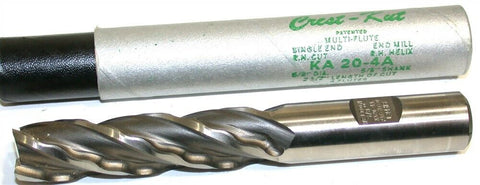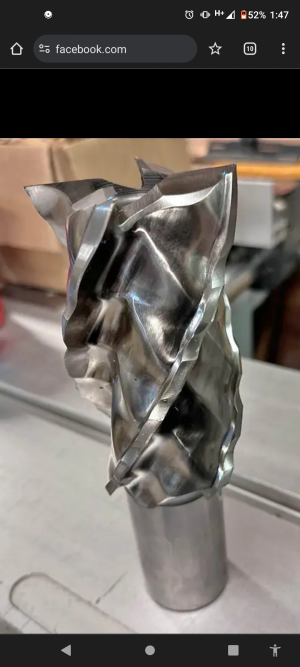-
Spring 2024 meetup in Calgary - date Saturday, April 20/2024. discussion Please RSVP Here to confirm and get your invitation and the location details. RSVP NOW so organizers can plan to get sufficient food etc. It's Tomorrow Saturday! you can still RSVP until I stop checking my phone tomorrow More info and agenda
-
We are having email/registration problems again. Diagnosis is underway. New users sorry if you are having trouble getting registered. We are exploring different options to get registered. Contact the forum via another member or on facebook if you're stuck. Update -> we think it is fixed. Let us know if not.
You are using an out of date browser. It may not display this or other websites correctly.
You should upgrade or use an alternative browser.
You should upgrade or use an alternative browser.
What kind of endmill is this?
- Thread starter justin1
- Start date
Matt-Aburg
Ultra Member
I am pretty sure this is a variable helix endmill. I have included info form a few sources.
Here is the text from source #1..
Understanding these tools, their benefits, and their applications can provide machinists and engineers with new opportunities to optimize their processes, increase efficiency, and achieve superior results. Whether you are dealing with challenging materials or striving to elevate the quality of your work, variable helix end mills offer a powerful tool to help you achieve your goals.
links below...

 medium.com
medium.com
and

 www.piranhamill.com
www.piranhamill.com
Here is the text from source #1..
Introduction to Variable Helix End Mills
Definition and Basics
Variable Helix End Mills are a specific type of end mill that features varying helix angles along the length of the flutes. Unlike standard end mills with a constant helix angle, these tools have flutes that twist at different angles. This unique design can significantly improve performance, reduce chatter, and increase productivity in many milling applications.Why Variable Helix?
The development of variable helix end mills has been a major advancement in milling technology. They were engineered to tackle some of the challenges that traditional end mills could not handle effectively.1. Chatter Reduction:
Chatter is a resonant vibration that can occur during milling, and it often leads to poor surface finishes and reduced tool life. Variable helix end mills disrupt the harmonics that cause chatter, ensuring a smoother operation.2. Improved Surface Finish:
By varying the helix angle, the cutting forces are distributed more evenly along the cutting edge. This leads to a more uniform wear and often results in a better surface finish.3. Enhanced Material Removal:
Variable helix end mills can be more efficient in material removal. By optimizing the helix angles for the material being cut, these tools can be more aggressive in their cut without sacrificing finish quality.4. Versatility:
These end mills can be used across various materials, including difficult-to-machine alloys. This versatility makes them valuable in shops that handle diverse projects.5. Adaptation to Different Machining Strategies:
High-efficiency milling (HEM) and other advanced milling strategies often require tools that can adapt to varying conditions. Variable helix end mills can be a vital part of these strategies.Design Considerations
The design of variable helix end mills requires careful consideration of the material, application, and desired outcomes. The varying helix angles must be meticulously engineered to match the specific requirements of the task at hand. Manufacturers often use complex algorithms to determine the optimal helix angles for different segments of the tool, ensuring that it performs efficiently across the entire cutting process.Variable Helix End Mills represent a remarkable innovation
Variable Helix End Mills represent a remarkable innovation in milling technology. By incorporating a varying helix design, these tools offer solutions to common machining problems like chatter, uneven wear, and inefficient material removal. They are not just a refinement of existing technology; they are a leap forward, providing advantages that can make a substantial difference in productivity, performance, and quality of work.Understanding these tools, their benefits, and their applications can provide machinists and engineers with new opportunities to optimize their processes, increase efficiency, and achieve superior results. Whether you are dealing with challenging materials or striving to elevate the quality of your work, variable helix end mills offer a powerful tool to help you achieve your goals.
links below...

What is a Variable Helix End Mill: Choosing the Right Helix Angle for Your Machining Application
In the world of machining, the end mill plays a pivotal role, and the helix angle of the end mill’s flutes significantly influences the…
 medium.com
medium.com
and

The technology behind Piranha Mills cutting tools
Discover the technology behind Piranha Mills' cutting tools, end mill, point drill, feed mill and endmill.
The definately look cool lol how do you find them?I have few of these - they are HSS so definitely meant for manual milling. They look cool.
Tom Kitta
Ultra Member
The definately look cool lol how do you find them?
Oh as most of my stuff its from auctions. They were in some lot with other stuff.
Haha ye that's good way to get em I meant how do you find using them.Oh as most of my stuff its from auctions. They were in some lot with other stuff.
I barely passed English class and it's my only language
140mower
Don
I always say that my English is pretty good for a second language........ Sadly it's the only one I know.I barely passed English class and it's my only language
Former Member
Guest
I suspect more of a specialized router bit for a particular profile.
Variable flute endmills are different in that it flute is not stepped like that and if you look carefully the are spaced slightly different and sometimes on a different rake.
The serrations are chip breakers and generally on roughing bits but not like that, lately I'm finding the new roughing bits don't have those anymore either.
What is interesting router bits and end mills can almost be identical. The biggest difference is the router bits are ground so they have less contact surface to reduce heat absorption as wood/wood chips don't transfer heat and only the bit does.
Variable flute endmills are different in that it flute is not stepped like that and if you look carefully the are spaced slightly different and sometimes on a different rake.
The serrations are chip breakers and generally on roughing bits but not like that, lately I'm finding the new roughing bits don't have those anymore either.
What is interesting router bits and end mills can almost be identical. The biggest difference is the router bits are ground so they have less contact surface to reduce heat absorption as wood/wood chips don't transfer heat and only the bit does.
My box says its patented "spiral-kut". From US (Cleveland, OH)
I don't see much of a difference - maybe you see it taking a bigger cut - finish is very good - same as with regular EM.
"Spiral-Kut" and "spiral-kut" both get zero hits on google.
Tom Kitta
Ultra Member
Me bad, it should be "Crest Kut"
![57_0d9325ea-b5df-4828-9707-d2d910e3f8bc_large.jpg]()
I have same gray box, with 3/4 EM.
You can buy them new on eBay - but feel pricey - https://www.ebay.com/itm/275166261600

I have same gray box, with 3/4 EM.
You can buy them new on eBay - but feel pricey - https://www.ebay.com/itm/275166261600
Former Member
Guest
Well that explains a lot as I believe that these are the precursors to modern chip breaker roughers.
Roughers even now seen to have less chip breakers. In the last couple of years cutter design seems to have progressed dramatically.
Roughers even now seen to have less chip breakers. In the last couple of years cutter design seems to have progressed dramatically.
Me bad, it should be "Crest Kut"
![57_0d9325ea-b5df-4828-9707-d2d910e3f8bc_large.jpg]()
I have same gray box, with 3/4 EM.
You can buy them new on eBay - but feel pricey - https://www.ebay.com/itm/275166261600
OK, that explains that. What is missing on these is the wavy pattern in between the cutting edges as per the original post by @justin1 above. The wavy pattern on the cutting edges is interesting on its own, but the pattern in between cutting edges is mesmerizing! My curiosity is killing me. I'd sure like to know what that's all about.
Matt-Aburg
Ultra Member

WELDON Crest-Kut® Multiple Flute High Speed Steel Roughing & Finishing Single End Mills
Roughing and finishing in one operation saves time and moneyFeaturesRough and finish in one operation.Minimum vibration and chatter.Efficient distribution of cutting temperatures.Compensating cutting forces.Greater productivity and higher profits.Minimum chip recutting.Maximum cutting edge...
 www.traverscanada.com
www.traverscanada.com
Expensive
Tom Kitta
Ultra Member

WELDON Crest-Kut® Multiple Flute High Speed Steel Roughing & Finishing Single End Mills
Roughing and finishing in one operation saves time and moneyFeaturesRough and finish in one operation.Minimum vibration and chatter.Efficient distribution of cutting temperatures.Compensating cutting forces.Greater productivity and higher profits.Minimum chip recutting.Maximum cutting edge...www.traverscanada.com
Expensive
I am shocked they are still for sale.
Former Member
Guest
I'm not if they have a following. Remember some on the site won't go carbideI am shocked they are still for sale.
Expensive
I am shocked they are still for sale.
Holy cow 100$ for 3/4 HSS cutter. It's 18$ at kms tools for 3/4 endmill and AliExpress it's 70$ for 20mm carbide endmill @ 55 HRC and 120$ for 20mm carbide roughing cutter @ 55HRCI'm not if they have a following. Remember some on the site won't go carbide. Could also be older stock.
I still feel like it's a CNC thing vs manual machining.It seems more beneficial to CNC were faster run time and less tool changing is a bonus. I feel like plastics or aluminum being most beneficial I can't see how it would perform better then carbide in steel and it's alloys
Matt-Aburg
Ultra Member
The only thing interesting to me about this endmill is it's shape.Holy cow 100$ for 3/4 HSS cutter. It's 18$ at kms tools for 3/4 endmill and AliExpress it's 70$ for 20mm carbide endmill @ 55 HRC and 120$ for 20mm carbide roughing cutter @ 55HRC
I still feel like it's a CNC thing vs manual machining.It seems more beneficial to CNC were faster run time and less tool changing is a bonus. I feel like plastics or aluminum being most beneficial I can't see how it would perform better then carbide in steel and it's alloys
Ye it is very interesting shape when I saw it on marketplace I had to take a another look thought someone was selling really messed up endmill.The only thing interesting to me about this endmill is it's shape.

